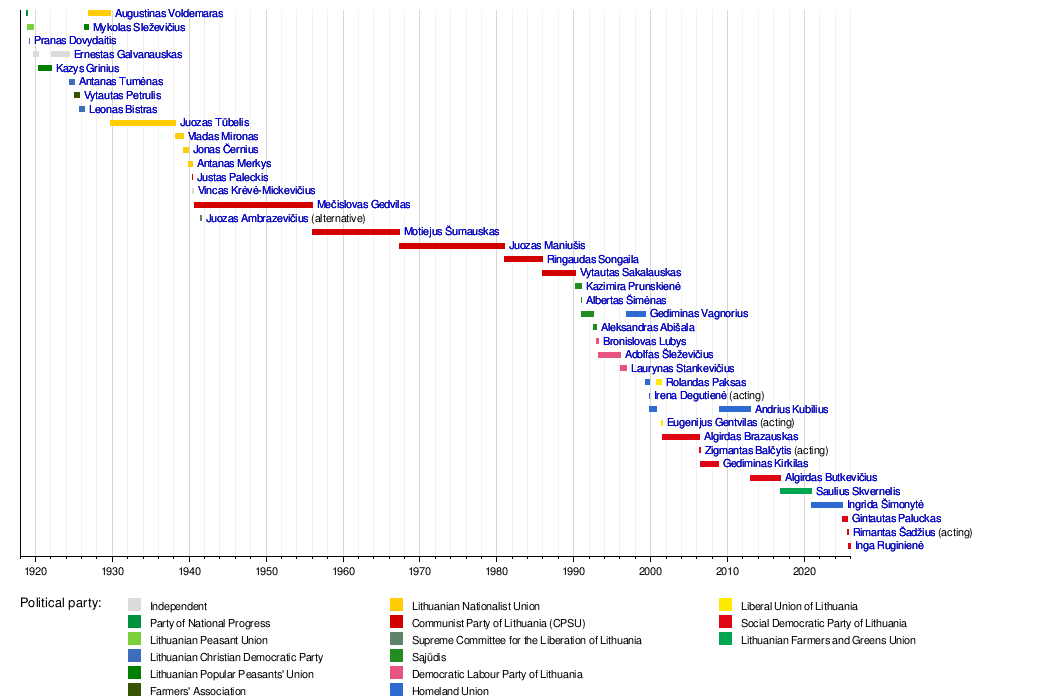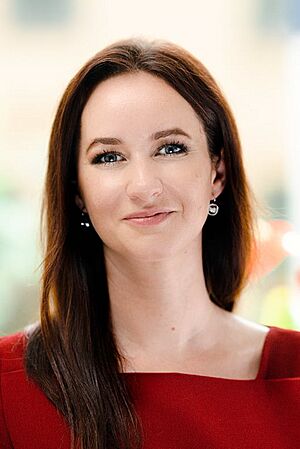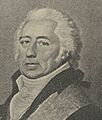Prime Minister of Lithuania facts for kids
Quick facts for kids Prime Minister of Lithuania |
|
|---|---|

|
|
| Government of Lithuania | |
| Style | Mister/Madam Prime Minister (informal) His/Her Excellency (diplomatic) |
| Appointer | President with the assent of the Seimas |
| Term length | 4 years
No term limit
|
| Formation | 11 November 1918 |
| First holder | Augustinas Voldemaras |
| Abolished | 1940–1991 |
| Deputy | Minister of Finance |
| Salary | €6,000 per month |
The Prime Minister of Lithuania is the main leader of the country's government. Think of them as the captain of the team that runs the country! The President chooses the Prime Minister, and the Seimas (Lithuania's parliament, which makes laws) must agree.
This important job, as we know it today, started in 1990 when Lithuania became independent again. Before that, from 1918 to 1940, Lithuania also had Prime Ministers. This was after the Russian Empire collapsed and before Lithuania's independence was interrupted for a period.
Contents
Leaders of Lithuania's Government
Early Leaders (1812)
For a short time in 1812, during a period of big changes in Europe, Lithuania had a special group called the Lithuanian Provisional Governing Commission. This group had leaders who managed the country's affairs. They included people like Józef Sierakowski and Stanisław Sołtan.
Leaders Before Soviet Times (1918–1940)
After Lithuania became independent in 1918, it had its own Prime Ministers. These leaders helped build the new country. They worked to set up the government and make laws. This period lasted until 1940, when Lithuania's independence was interrupted. Some important Prime Ministers from this time were Augustinas Voldemaras and Mykolas Sleževičius.
In June 1940, the Soviet Union entered Lithuania. This led to big changes in the government. The President at the time left the country. A new government was formed, but its leaders are not seen as truly legitimate by modern Lithuania.
Leaders During Soviet Times (1940–1990)
During the time Lithuania was part of the Soviet Union, the country did not have a Prime Minister in the same way. Instead, the government was led by Chairmen of the Council of People's Commissars and later Chairmen of the Council of Ministers. These leaders followed the rules of the Communist Party of Lithuania. This period lasted until Lithuania regained its independence in 1990.
Prime Ministers of Modern Lithuania (1990–Present)
Since 11 March 1990, after Lithuania declared its independence again, the country has had Prime Ministers. Here is a list of the people who have held this important role.
Political parties and affiliations: Sąjūdis LDDP TS / TS-LKD LLS LSDP LVŽS
| No. | Portrait | Name (born–died) |
Term of office | Political party | Government coalition |
Seimas | |||
|---|---|---|---|---|---|---|---|---|---|
| Took office | Left office | Time in office | |||||||
| 1 |  |
Kazimira Danutė Prunskienė (born 1943) |
17 March 1990 | 10 January 1991 | 299 days | Independent (endorsed by Sąjūdis) |
Prunskienė Sąjūdis |
Supreme Council – Reconstituent Seimas (1990) | |
| 2 |  |
Albertas Šimėnas (born 1950) |
10 January 1991 | 13 January 1991 | 3 days | Independent (endorsed by Sąjūdis) |
Šimėnas Sąjūdis |
||
| 3 |  |
Gediminas Vagnorius (born 1957) |
13 January 1991 | 21 July 1992 | 1 year, 190 days | Independent (endorsed by Sąjūdis) |
Vagnorius I Sąjūdis |
||
| 4 |  |
Aleksandras Abišala (born 1955) |
21 July 1992 | 26 November 1992 | 128 days | Independent (endorsed by Sąjūdis) |
Abišala Sąjūdis |
||
| 5 |  |
Bronislovas Lubys (1938–2011) |
12 December 1992 | 10 March 1993 | 88 days | Independent (endorsed by LDDP) |
Lubys LDDP |
6 (1992) | |
| 6 | Adolfas Šleževičius (1948–2022) |
10 March 1993 | 8 February 1996 | 2 years, 335 days | Democratic Labour Party (LDDP) |
Šleževičius LDDP |
|||
| 7 | Laurynas Mindaugas Stankevičius (1935–2017) |
23 February 1996 | 19 November 1996 | 270 days | Democratic Labour Party (LDDP) |
Stankevičius LDDP |
|||
| (3) |  |
Gediminas Vagnorius (born 1957) |
4 December 1996 | 3 May 1999 | 2 years, 150 days | Homeland Union (TS) |
Vagnorius II TS–LKDP–LCS (1996–1998) TS–LKDP–LCS–LDDP (1998–1999) |
7 (1996) | |
| 8 |  |
Rolandas Paksas (born 1956) |
1 June 1999 | 27 October 1999 | 148 days | Homeland Union (TS) |
Paksas I TS–LKDP–LCS |
||
| – |  |
Irena Degutienė (born 1949) acting |
27 October 1999 | 3 November 1999 | 7 days | Homeland Union (TS) |
Paksas I TS–LKDP–LCS |
||
| 9 |  |
Andrius Kubilius (born 1956) |
3 November 1999 | 19 October 2000 | 351 days | Homeland Union (TS) |
Kubilius I TS–LKDP |
||
| (8) |  |
Rolandas Paksas (born 1956) |
27 October 2000 | 20 June 2001 | 236 days | Liberal Union (LLS) |
Paksas II LLS-NS-LCS-MKDS-LLRA |
8 (2000) | |
| – |  |
Eugenijus Gentvilas (born 1960) acting |
20 June 2001 | 4 July 2001 | 14 days | Liberal Union (LLS) |
Paksas II LLS-NS-LCS-MKDS-LLRA |
||
| 10 |  |
Algirdas Brazauskas (1932–2010) |
4 July 2001 | 1 June 2006 | 4 years, 332 days | Social Democrats (LSDP) |
Brazauskas I LSDP-NS |
||
| Brazauskas II LSDP–DP-LVNDS-NS (2004–2006) LSDP–DP-LVNDS (2006) LSDP (2006) |
9 (2004) | ||||||||
| – |  |
Zigmantas Balčytis (born 1953) acting |
1 June 2006 | 18 July 2006 | 47 days | Social Democrats (LSDP) |
Brazauskas II LSDP |
||
| 11 |  |
Gediminas Kirkilas (1951–2024) |
6 July 2006 | 17 November 2008 | 2 years, 134 days | Social Democrats (LSDP) |
Kirkilas LSDP-LVNDS-PDP-LiCS (2006–2008) LSDP-LVNDS-LiCS-PDP-NS (2008) |
||
| (9) |  |
Andrius Kubilius (born 1956) |
9 December 2008 | 13 December 2012 | 4 years, 4 days | Homeland Union (TS-LKD) |
Kubilius II TS-LKD-TPP-LRLS-LiCS (2008–2009 and 2010–2011) TS-LKD-TPP-LRLS-LiCS-Parliamentary Group "One Lithuania" (2009–2010) TS-LKD-LRLS-LiCS (2011–2012) |
10 (2008) | |
| 12 |  |
Algirdas Butkevičius (born 1958) |
13 December 2012 | 13 December 2016 | 4 years, 0 days | Social Democrats (LSDP) |
Butkevičius LSDP-DP-TT-LLRA (2012–2014) LSDP-DP-TT (2014–2016) |
11 (2012) | |
| 13 |  |
Saulius Skvernelis (born 1970) |
13 December 2016 | 11 December 2020 | 3 years, 364 days | Independent (endorsed by LVŽS) |
Skvernelis LVŽS-LSDP (2016–2017) LVŽS-Parliamentary Group "Social Democratic Labour" (2017–2018) LVŽS-LSDDP (2018–2019) LVŽS-LSDDP-LLRA-KŠS-TT (2019) LVŽS-LSDDP-LLRA-KŠS (2019–2020) |
12 (2016) | |
| 14 |  |
Ingrida Šimonytė (born 1974) |
11 December 2020 | 12 December 2024 | 4 years, 1 day | Homeland Union (TS-LKD) |
Šimonytė TS-LKD-LRLS-LP |
13 (2020) | |
| 15 |  |
Gintautas Paluckas (born 1979) |
12 December 2024 | 4 August 2025 | 235 days | Social Democrats (LSDP) |
Paluckas LSDP-PPNA-DSVL |
14 (2024) | |
| – |  |
Rimantas Šadžius (born 1960) acting |
4 August 2025 | 25 September 2025 | 52 days | Social Democrats (LSDP) |
Paluckas LSDP-PPNA-DSVL |
||
| 16 |  |
Inga Ruginienė (born 1981) |
25 September 2025 | Incumbent | 70 days | Social Democrats (LSDP) |
Ruginienė LSDP-PPNA-LVŽKŠS |
||
See also
- Lists of office-holders
- Grand Chancellor of Lithuania
Timeline

Images for kids



















